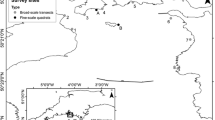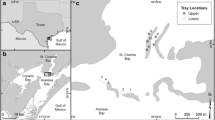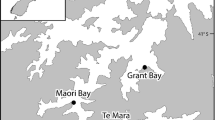Abstract
The introduction of non-native species occurs within a context of other anthropogenic impacts: thus a holistic approach is needed to understand interactive effects. Installation of shoreline protection structures is increasing in response to rising sea levels and increasing frequency of intense storms. Shoreline hardening structures can facilitate establishment of non-native species with multiple potential consequences. We measured abundances of both native and non-native Codium, a green macroalga, on natural hard substrates (oyster reefs) and artificial substrates (bulkheads and revetments) in two estuaries and assessed the effects of each Codium species on nitrogen fixation and net N2 fluxes. Native C. decorticatum was the most abundant (86 %) Codium on oyster reefs, while exotic C. fragile dominated (99 %) artificial substrates. N2 production via denitrification was greater than nitrogen fixation for both species and the net N2 production associated with non-native C. fragile was greater than with native C. decorticatum. Comparing our results with surveys conducted in the 1940s before C. fragile had invaded, indicates that non-native Codium has outcompeted native Codium on artificial substrates, but that natural substrate provided by oyster reefs remains a refuge for native Codium. Although shoreline hardening with artificial structures can reduce ecosystem services provided by coastal marsh and other habitats, an unexpected beneficial consequence was the N2 production associated with the non-native Codium, which has the potential to mitigate anthropogenic nutrient loading. Our results illustrate that the interaction between multiple anthropogenic impacts can be positive, and indicate that non-ephemeral macroalgae could be an overlooked component in nitrogen removal from marine ecosystems by enhancing denitrification.




Similar content being viewed by others
References
Anton A, Cebrian J, Heck KL et al (2011) Decoupled effects (positive and negative) of nutrient enrichment on ecosystem services. Ecol Appl 21:991–1009
Barbier E, Hacker S, Kennedy C et al (2011) The value of estuarine and coastal ecosystem services. Ecol Monogr 81:169–193. doi:10.1890/10-1510.1
Beck MW, Brumbaugh RD, Airoldi L et al (2011) Oyster reefs at risk and recommendations for conservation, restoration, and management. Bioscience 61:107–116. doi:10.1525/bio.2011.61.2.5
Bodkin JL (1988) Effects of kelp forest removal on associated fish assemblages in central California. J Exp Mar Biol Ecol 117:227–238. doi:10.1016/0022-0981(88)90059-7
Brush GS (2008) Historical land use, nitrogen, and coastal eutrophication: a paleoecological perspective. Estuar Coasts 32:18–28
Bulleri F, Airoldi L (2005) Artificial marine structures facilitate the spread of a non-indigenous green alga, Codium fragile ssp. tomentosoides, in the north Adriatic Sea. J Appl Ecol 42:1063–1072
Byers JE (2002) Impact of non-indigenous species on natives enhanced by anthropogenic alteration of selection regimes. Oikos 97:449–458. doi:10.1034/j.1600-0706.2002.970316.x
Byers JE, Gribben PE, Yeager C, Sotka EE (2012) Impacts of an abundant introduced ecosystem engineer within mudflats of the southeastern US coast. Biol Invasions 14:2587–2600. doi:10.1007/s10530-012-0254-5
Carr M (1994) Effects of macroalgal dynamics on recruitment of a temperate reef fish. Ecology 75:1320–1333. doi:10.2307/1937457
Carroll JM, Peterson BJ, Bonal D et al (2010) Comparative survival of bay scallops in eelgrass and the introduced alga, Codium fragile, in a New York estuary. Mar Biol 157:249–259
Cloern J (2001) Our evolving conceptual model of the coastal eutrophication problem. Mar Ecol Prog Ser 210:223–253
Conley DJ, Paerl HW, Howarth RW et al (2009) Controlling eutrophication: nitrogen and phosphorus. Science 323:1014–1015
Cornwell JC, Kemp WM, Kana TM (1999) Denitrification in coastal ecosystems: methods, environmental controls, and ecosystem level controls, a review. Aquat Ecol 33:41–54
Crawley MJ (2007) The R book. Wiley, Hoboken, N.J
Crooks JA (2002) Characterizing ecosystem-level consequences of biological invasions: the role of ecosystem engineers. Oikos 97:153–166. doi:10.1034/j.1600-0706.2002.970201.x
Davis MA, Chew MK, Hobbs RJ et al (2011) Don’t judge species on their origins. Nature 474:153–154
Didham RK, Tylianakis JM, Gemmell NJ et al (2007) Interactive effects of habitat modification and species invasion on native species decline. Trends Ecol Evol 22:489–496
Duarte CM (1995) Submerged aquatic vegetation in relation to different nutrient regimes. Ophelia 41:87–112
Dumont CP, Harris LG, Gaymer CF (2011) Anthropogenic structures as a spatial refuge from predation for the invasive bryozoan Bugula neritina. Mar Ecol Prog Ser 427:95–103. doi:10.3354/meps09040
Eriksson PG (2001) Interaction effects of flow velocity and oxygen metabolism on nitrification and denitrification in biofilms on submersed macrophytes. Biogeochemistry 55:29
Eriksson PG, Weisner S (1996) Functional differences in epiphytic microbial communities in nutrient-rich freshwater ecosystems: an assay of denitrifying capacity. Freshw Biol 36:555–562
Eriksson PG, Weisner S (1997) Nitrogen removal in a wastewater reservoir: the importance of denitrification by epiphytic biofilms on submersed vegetation. J Environ Qual 26:905–910
Eriksson PG, Weisner SEB (1999) An experimental study on effects of submersed macrophytes on nitrification and denitrification in ammonium-rich aquatic systems. Limnol Oceangr 44:1993–1999
Eyre BD, Rysgaard S, Dalsgaard T, Christensen PB (2002) Comparison of isotope pairing and N2:Ar methods for measuring sediment denitrification—Assumption, modifications, and implications. Estuaries 25:1077–1087. doi:10.1007/BF02692205
Eyre BD, Ferguson AJP, Webb A et al (2010) Denitrification, N-fixation and nitrogen and phosphorus fluxes in different benthic habitats and their contribution to the nitrogen and phosphorus budgets of a shallow oligotrophic sub-tropical coastal system (southern Moreton Bay, Australia). Biogeochemistry 102:111–133. doi:10.1007/s10533-010-9425-6
FitzGerald D, Fenster M, Argow B, Buynevich I (2008) Coastal impacts due to sea-level rise. Annu Rev Earth and Planetary Science 36:601–647
Gerard V, Dunham S, Rosenberg G (1990) Nitrogen fixation by cyanobacteria associated with Codium fragile (Chlorophyta): environmental effects and transfer of fixed nitrogen. Mar Biol 105:1–8
Goecke F, Labes A, Wiese J, Imhoff JF (2010) Chemical interactions between marine macroalgae and bacteria. Mar Ecol Prog Ser 409:267–300
Gribben PE, Byers JE, Wright JT, Glasby TM (2013) Positive versus negative effects of an invasive ecosystem engineer on different components of a marine ecosystem. Oikos 122:816–824. doi:10.1111/j.1600-0706.2012.20868.x
Halpern BS, Walbridge S, Selkoe KA et al (2008) A global map of human impact on marine ecosystems. Science 319:948–952
Hanisak MD (1979) Growth patterns of Codium fragile ssp. tomentosoides in response to temperature, irradiance, salinity, and nitrogen source. Mar Biol 50:319–332. doi:10.1007/BF00387009
Hanisak MD, Harlin MM (1978) Uptake of inorganic nitrogen by Codium fragile subsp tomentosoides (chlorophyta). J Phycol 14:450–454
Hardison AK, Anderson IC, Canuel EA et al (2011) Carbon and nitrogen dynamics in shallow photic systems: interactions between macroalgae, microalgae, and bacteria. Limnol Oceanogr 56:1489–1503. doi:10.4319/lo.2011.56.4.1489
Harris L, Jones A (2005) Temperature, herbivory and epibiont acquisition as factors controlling the distribution and ecological role of an invasive seaweed. Biol Invasions 7:913–924
Head W, Carpenter E (1975) Nitrogen-fixation associated with marine macroalga Codium fragile. Limnol Oceanogr 20:815–823
Howarth R, Marino R, Lane J, Cole J (1988) Nitrogen-fixation in fresh-water, estuarine, and marine ecosystems rates and importance. Limnol Oceanogr 33:669–687
IPCC (2007) Climate change 2007: the physical science basis, summary for policy-makers
Khailov KM, Burlakova ZP (1969) Release of dissolved organic matter by marine seaweeds and distribution of their total organic production to inshore communities. Limnol Oceanogr 14:512–527
Kittinger JN, Ayers AL (2010) Shoreline armoring, risk management, and coastal resilience under rising seas. Coast Manag 38:634–653
Krause-Jensen D, Christensen PB, Rysgaard S (1999) Oxygen and nutrient dynamics within mats of the filamentous macroalga Chaetomorpha linum. Estuaries 22:31–38. doi:10.2307/1352924
Lavrentyev PJ, Gardner WS, Yang LY (2000) Effects of the zebra mussel on nitrogen dynamics and the microbial community at the sediment-water interface. Aquat Microb Ecol 21:187–194. doi:10.3354/ame021187
Levin PS, Coyer JA, Petrik R, Good TP (2002) Community-wide effects of nonindigenous species on temperate rocky reefs. Ecology 83:3182–3193. doi:10.1007/s00300-011-1080-4
Lotze H, Lenihan H, Bourque B et al (2006) Depletion, degradation, and recovery potential of estuaries and coastal seas. Science 312:1806–1809
Lutz ML, Davis AR, Minchinton TE (2010) Non-indigenous macroalga hosts different epiphytic assemblages to conspecific natives in southeast Australia. Mar Biol 157:1095–1103
Mack RN, Simberloff D, Lonsdale WM et al (2000) Biotic invasions: causes, epidemiology, global consequences, and control. Ecol Appl 10:689–710
Magalhäes CM, Wiebe WJ, Joye SB, Bordalo AA (2005) Inorganic nitrogen dynamics in intertidal rocky biofilms and sediments of the Douro River estuary (Portugal). Estuaries 28:592–607. doi:10.1007/BF02696070
Mathieson AC, Dawes CJ, Harris L, Hehre E (2003) Expansion of the Asiatic green alga Codium fragile subsp. tomentosoides in the Gulf of Maine. Rhodora 105:1–53
McCarthy MJ, Gardner WS (2003) An application of membrane inlet mass spectrometry to measure denitrification in a recirculating mariculture system. Aquaculture 218:341–355. doi:10.1016/S0044-8486(02)00581-1
McGlathery KJ, Sundbck K, Anderson IC (2007) Eutrophication in shallow coastal bays and lagoons: the role of plants in the coastal filter. Mar Ecol Prog Ser 348:1–18
Miller-Way T, Twilley R (1996) Theory and operation of continuous flow systems for the study of benthic-pelagic coupling. Mar Ecol Prog Ser 140:257–269
Neill PE, Alcalde O, Faugeron S et al (2006) Invasion of Codium fragile ssp. tomentosoides in northern Chile: a new threat for Gracilaria farming. Aquaculture 259:202–210
Nielsen LP, Christensen PB, Revsbech NP, Sørensen J (1990) Denitrification and oxygen respiration in biofilms studied with a microsensor for nitrous oxide and oxygen. Microb Ecol 19:63–72
Nyberg CD, Wallentinus I (2005) Can species traits be used to predict marine macroalgal introductions? Biol Invasions 7:265–279
Pejchar L, Mooney HA (2009) Invasive species, ecosystem services and human well-being. Trends Ecol Evol 24:497–504. doi:10.1016/j.tree.2009.03.016
Peterson MS, Comyns BH, Hendon JR et al (2000) Habitat use by early life-history stages of fishes and crustaceans along a changing estuarine landscape: differences between natural and altered shoreline sites. Wetl Ecol Manag 8:209–219. doi:10.1023/A:1008452805584
Piehler MF, Smyth AR (2011) Habitat-specific distinctions in estuarine denitrification affect both ecosystem function and services. Ecosphere 2:art12
Posey MH (1988) Community changes associated with the spread of an introduced seagrass, Zostera japonica. Ecology 69:974–983. doi:10.2307/1941252
Rosenberg G, Paerl H (1981) Nitrogen fixation by blue green algae associated with the siphonous green seaweed Codium decorticatum: effects on ammonium uptake. Mar Biol 61:151–158
Schlaepfers MA, Sax DF, Olden JD (2011) The potential conservation value of non-native species. Conserv Biol 25:428–437
Searles RB, Schneider C (1991) Seaweeds of the southeastern United States : Cape Hatteras to Cape Canaveral. Duke University Press, Durham
Searles R, Hommersand M, Amsler C (1984) The occurrence of Codium fragile subsp tomentosoides and (Chlorophyta) in North Carolina. Bot Mar 27:185–187
Seitz R, Lipcius R, Olmstead N et al (2006) Influence of shallow-water habitats and shoreline development on abundance, biomass, and diversity of benthic prey and predators in Chesapeake Bay. Mar Ecol Prog Ser 326:11–27
Silliman BR, Bertness MD (2004) Shoreline development drives invasion of Phragmites australis and the loss of plant diversity on New England salt marshes. Conserv Biol 18:1424–1434. doi:10.1111/j.1523-1739.2004.00112.x
Tall L, Caraco N, Maranger R (2011) Denitrification hot spots: dominant role of invasive macrophyte Trapa natans in removing nitrogen from a tidal river. Ecol Appl 21:3104–3114. doi:10.1890/11-0061.1
Thomsen MS, Silliman BR, McGlathery KJ (2007) Spatial variation in recruitment of native and invasive sessile species onto oyster reefs in a temperate soft-bottom lagoon. Estuar Coast Shelf Sci 72:89–101
Titus J, Park R, Leatherman S et al (1991) Greenhouse-effect and sea-level rise-The cost of holding back the sea. Coast Manag 19:171–204
Trowbridge CD (1998) Ecology of the green macroalga Codium fragile: invasive and non-invasive subspecies. Oceanography and Marine Biology. Ucl Press, Philadelphia, pp 1–64
Tyler A, McGlathery K, Anderson I (2003) Benthic algae control sediment-water column fluxes of organic and inorganic nitrogen compounds in a temperate lagoon. Limnol Oceanogr 48:2125–2137
Tyler AC, Lambrinos JG, Grosholz ED (2007) Nitrogen inputs promote the spread of an invasive marsh grass. Ecol Appl 17:1886–1898. doi:10.1890/06-0822.1
Tyrrell M, Byers J (2007) Do artificial substrates favor nonindigenous fouling species over native species? J Exp Mar Biol Ecol 342:54–60
Vitousek P, Mooney H, Lubchenco J, Melillo J (1997) Human domination of earth’s ecosystems. Science 277:494–499
Wasson K, Fenn K, Pearse J (2005) Habitat differences in marine invasions of central California. Biol Invasions 7:935–948
Williams L (1948) The genus Codium in North Carolina. J Mitchell Soc 67:133–161
Winder M, Jassby AD, Mac Nally R (2011) Synergies between climate anomalies and hydrological modifications facilitate estuarine biotic invasions. Ecol Lett 14:749–757. doi:10.1111/j.1461-0248.2011.01635.x
Acknowledgments
We thank J. Fegley, S. Thompson, M. Simpson, M. Vozzo, B. VanDusen, L. Brown, L. Dee, W. Rogers, C. Martin, V. Pinkerton, M. McQuillan, C. Bland, J. Meiners, J. Moore, S. Vos and C. Biddle for help with the research and A. Anton, B. VanDusen, J. Fodrie, and S. Fegley for improving the manuscript. This research was conducted in the National Estuarine Research Reserve System under awards from the Estuarine Reserves Division, Office of Ocean and Coastal Resource Management, National Ocean Service, National Oceanic and Atmospheric Administration. The authors have no conflict of interest.
Author information
Authors and Affiliations
Corresponding author
Electronic supplementary material
Below is the link to the electronic supplementary material.
Rights and permissions
About this article
Cite this article
Geraldi, N.R., Smyth, A.R., Piehler, M.F. et al. Artificial substrates enhance non-native macroalga and N2 production. Biol Invasions 16, 1819–1831 (2014). https://doi.org/10.1007/s10530-013-0629-2
Received:
Accepted:
Published:
Issue Date:
DOI: https://doi.org/10.1007/s10530-013-0629-2




